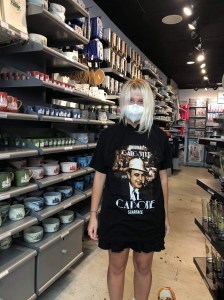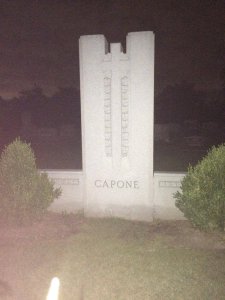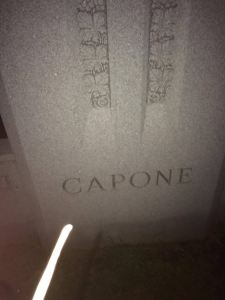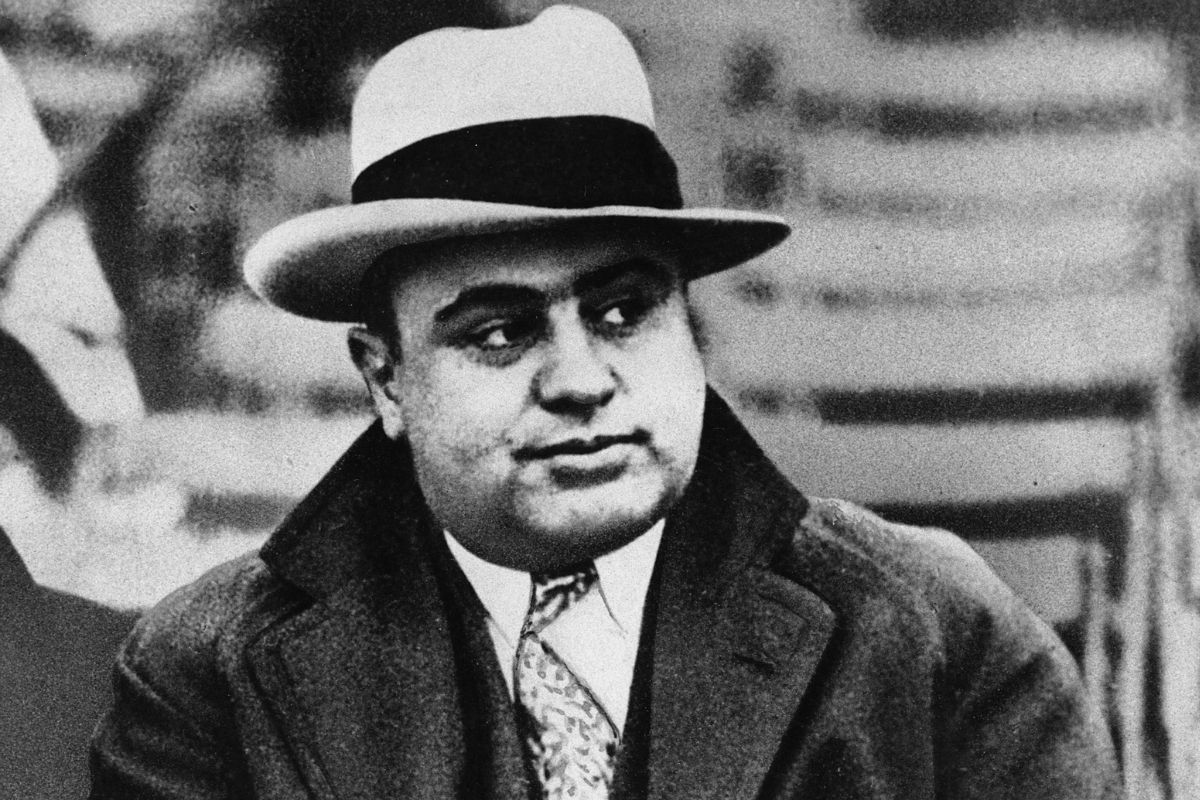Al Capone is buried straight west of the Chicago city limits in Mount Carmel Cemetery. And though Capone’s crime reign left a long-lasting stigma on the city, his laughing likeness gets printed on T-shirts, coffee mugs, and oh so many shot glasses. The ruthless bootlegger is the biggest folk hero for our complicated town.
Videos by Rare
As a third-generation Chicagoan myself, I grew up fascinated by the original gangster. In fifth grade, I came in second place at the school history fair for my one-woman re-enactment of the St. Valentine’s Day Massacre. (Many fedoras were used.) After prom, my friends and I rented a room at the infamous Congress Hotel. And when I turned 21, I excitedly went to the Green Mill jazz lounge and waited for a seat in Capone’s old spot: the cozy corner booth. (Legend has it that Capone’s underground tunnels still exist, stretching out from his favorite club across Uptown.)
So during college when a friend offered to drive, I jumped at the chance to visit Al Capone’s grave. Mount Carmel Cemetery is only a 30-minute trip from my parent’s house and before we left, I found my old, glow-in-the-dark Oujia Board was still sitting in my childhood bedroom. I brought the board with me, ready for adventure. And let me tell you, something happened on that gravestone that night… and I have the pictures to prove it.
First, a Bit of History
Alphonse Capone was actually not born in Chicago. He grew up in New York City, raised by Italian immigrant parents. After getting involved with the mafia there, first as a brothel bouncer, Capone moved to Chicago in 1919 to become a bodyguard for the powerful gangster Johnny Torrio. Torrio was in the process of planning a vast Chicago bootlegging network and Capone’s close access made him the boss’s confidante. At the start of Prohibition in 1920, Torrio headed the Chicago Outfit, a Southside branch of the Italian mafia which, in addition to running alcohol, organized gambling, loansharking, prostitution, racketeering, and of course, murder. And although the Chicago Outfit’s grip on local illegal activities was strong, their control was marred by ongoing, bloody conflicts with the rival North Side Gang.
After an assassination attempt on Johnny Torrio in 1925, Al Capone assumed leadership of the Chicago Outfit. He was only 26. Abandoning Torrio’s more careful methods, Capone employed extreme violence to make a bigger profit. If a store didn’t want to buy liquor from the Outfit, Capone blew the establishment up. The collateral damage was rampant. Within the government, Capone found protection in the deeply corrupt politicians at City Hall. He also had a heavy hand in the election of the flamboyantly crooked Mayor “Big Bill” Thompson. (Thompson the last Republican mayor to ever hold office in Chicago.) But Capone feared for his own safety in the city and lived mainly in Cicero, Illinois with a constant entourage of bodyguards.
The Imprisonment and Death of Al Capone
Even though Al Capone was instantly recognizable throughout Chicago, and beyond, for his wildly violent leadership style, he finally went to jail for… tax evasion. After the infamy of the St. Valentine’s Day Massacre, in which 7 of the North Side Gang were brutally murdered in a Lincoln Park garage, there was a national push to put Capone behind bars. In 1931, unable to account for his excessive income, Capone was charged with 22 counts of federal tax evasion. He was sentenced to prison at Atlanta U.S. Penitentiary the following year, where he was officially diagnosed with syphilis and gonorrhea. It’s believed that Capone contracted the STDs when he was a teenager in New York City, meaning the infections had been festering for decades. His mental abilities suffered as a result. Capone spent his time in Atlanta on the verge of a nervous breakdown, penning incomprehensible letters back home. In 1934, he was transferred to Alcatraz Federal Penitentiary: an intimidating prison off the rough coast of San Francisco.
In 1939, Al Capone was released from prison due to his failing health. He received various treatments, but by 1946 his doctor concluded that Capone had the brain function of a child. He spent his final years living in a mansion in Florida with his wife, Mae Capone. In 1947, the legendary gangster’s heart finally failed. He died at the age of 48. His body was transported back to Chicago and buried at Mount Olivet Cemetery in the city. In 1950, his remains, along with his father Gabriele’s and his brother Salvatore’s, were moved to Mount Carmel Cemetery in Hillside, Illinois.
Summoning the Spirit of Scarface

In addition to Al Capone, Mt. Carmel Cemetery is the final resting place for a number of Chicago legends — mainly in the field of organized crime. As it’s a Roman Catholic cemetery, most interred there are Italian though there are some notable exceptions. Capone’s former nemesis, Irish mobster Dean O’Banion is buried at Mt. Carmel. But when my friends and I arrived on that late August night, we only had eyes for the grave of Al Capone.
Findagrave.com lists Al Capone’s exact burial location is in Section 35. The site also includes some helpful information: “At the Roosevelt, entrance go right approx 6 markers and there is a large gray marker with the name Capone on it.” I had searched up the placement of Al Capone’s grave on my phone while my friend Nicole was driving toward the suburb of Hillside. It was nearing midnight when we spontaneously decided to find the grave. Five of our friends packed into the tight car that night. In a week or so, we would all be leaving Chicago, cross country, to return to our respective colleges. So this outing was an impulsive escapade for us, stretching out the last bit of our last youthful summer.
When we arrived at Mt. Carmel, Nicole parked on a quiet residential road. The five of us tip-toed along the edge of the wrought iron fence, looking for damages: holes or spots where the poles were bent out of shape. It didn’t take long to find a ramshackle entrance, big enough to slip through. Under my arm, I carried the old Ouijia board tightly. Once we were inside the graveyard, we sought out a directory and quickly found Capone’s grave by following the plot signs. His burial site is surprisingly modest; no mausoleum or large display. Capone’s personal headstone lies flat in the grass, engraved with a cross and the words: My Jesus Mercy. Buried beside him are family members Gabriele Capone, Salvatore Capone, Ralph Capone, and Frank Capone. (Al’s wife Mae is buried in Florida.) Designating the entire Capone plot is a tall, grey gravestone that reads CAPONE in prominent letters. This marker is traditionally what’s pictured as the Capone tombstone. It’s an ornate, cross structure between two shrubs. This large cross is the only clear monument to Capone in the Chicagoland area.
My friends and I kneeled on the ground around its base, in a circle. We placed the Oujia board gingerly between our knees. Its glow-in-the-dark surface emanated pale green in the moonlight. I removed the plastic planchette from my sweatshirt pocket and we all leaned in, tense and ready. “If there is a spirit present, make yourself known!” I said. As there were five of us in the graveyard that night, ten hands sat trembling on the Ouija board’s plastic decoder. The planchette twirled maniacally: K… L… L… it paused. “Kill?” We wondered. “How many people did you kill?” Our arms stayed perched, waiting for instruction. My Ouija board is curved in the middle, like a bridge, due to water damage. This arch it caused the planchette to dip suddenly half-way through the alphabet. The pointed end began to twitch down, and lower, toward the numbers 3… 5… “Thirty-five?” We wondered aloud.
Al Capone’s Tombstone


That kill count must have made sense to us because the planchette stopped moving. “Al, who did you, love?” One of us asked. And that answer was quick; most Chicago kids know the name of Mae Capone, and so it was no surprise when the planchette scaled the board again. It spelled out M… B… E… Close enough.
“Hey Al, is it true you died of syphilis?”
I don’t know exactly what happened next. I just remember thinking that the Ouija board looked so right next to Al Capone’s headstone. There’s no rest for spirits here… too many teen vandals. I doubt we were the first rowdy ones to try conjuring Capone’s presence. We probably weren’t even the first that week, judging by the widened holes in Mt. Carmel’s wiry fence. But how special the Ouija board looked, there, curving up from the dirt in eerie lamplight against speckled limestone.
My friend Nathan must have thought so too. He whipped his iPhone out for a quick picture. But when he pressed the shutter button, his whole phone started to vibrate and the screen turned hot pink, then BSOD blue, then a sudden camera flash ignited and the whole device powered down. He looked up at the rest of us, shocked, but we had no explanation. We all started to run like mad, out through the cemetery, bounding over gravesites and tripping over wreaths. We leapt back over the fence like it was nothing. Back in the car, everyone sat panting, invigorated, and passed Nathan’s phone around, which was still hot. A few hours later, Nathan’s phone turned back on. And there was a picture of a ghost on it.
Of course, it’s a modern phenomenon of “paranormal” photography, recording glowing orbs and warped camera flashes. But the picture on Nathan’s phone seemed pretty direct: a close shot of the word CAPONE, and under it, a thick glowing line. The line was neon white and looked like an outstretched finger to me, and a shadow was cast beneath it onto the patch of grass. There are two shots of the apparition. And in the second, it seems, the heat is moving closer.



